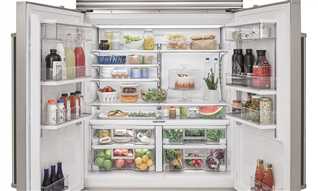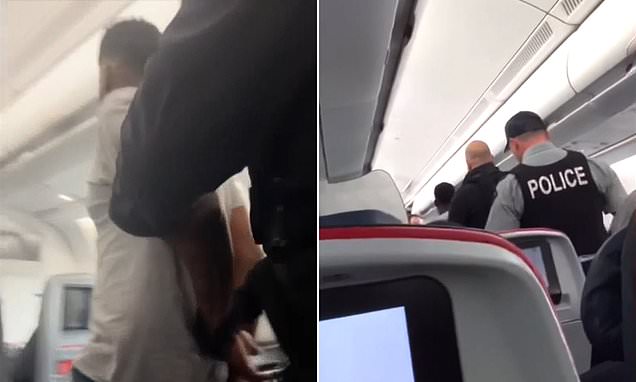Why does this fridge cost 24k? Cool celebs love them, top chefs are hot for them and US brand Sub-Zero’s fridge-freezers are now a hit in British kitchens. Maddy Fletcher finds out whether they live up to their shiver-inducing price tag
- Maddy Fletcher finds out why Sub-Zero’s fridge-freezers are so expensive
- READ MORE: The Streets viewers stunned as woman spends £35,000 on luxury kitchen – but people say it ‘looks like she got it in IKEA’
Before any Sub-Zero fridge can leave the factory, it has to pass what you might call the lettuce test.
It works like this: factory workers pop a head of lettuce inside the fridge and keep it there for two weeks. If the leaves stay fresh for a fortnight, the fridge is good to go. If they’re even slightly soggy, it’s not.
To ensure the lettuce is top quality, it is farmed onsite in a designated growing area.
This is the mad world of Sub-Zero, a US-based company that makes seriously expensive fridges.
I mean really, properly, seriously expensive. At Sub-Zero, small ‘under-counter’ fridges start at £4,320; larger, double-doored products can go for £35,400.
Cooks love them – Thomasina Miers, James Martin and Gordon Ramsay are all owners – and so do celebrities.
At Sub-Zero, small ‘under-counter’ fridges start at £4,320; larger, double-doored products, such as the one pictured above, can go for £35,400
In an article in this newspaper from 2014, Prince William and Kate had them in their kitchens in Norfolk and in Kensington Palace.
Other high-profile Sub-Zeroers include Madonna, Gary Lineker, Rod Stewart, Kourtney Kardashian, Reese Witherspoon, Sting and Sir Paul McCartney.
Even the late Pope Benedict XVI had one of the wine-cooling units.
The business was founded in 1945 by Westye Bakke, a fridge engineer from Madison, Wisconsin who worked briefly for the great American architect Frank Lloyd Wright.
Bakke built the first Sub-Zero in his garage, mainly because his son, Bud, was diabetic and he needed a decent fridge in which to keep his insulin cool.
The company is still run by the Bakke family – and still based in Madison – except that now Sub-Zero has around 8,000 employees worldwide and operates out of a 200-acre factory rather than a poky garage.
In 1999, the first of the fridges arrived in Britain and, according to Sub-Zero’s UK managing director Ricky Davies, the company now accounts for roughly five per cent of our refrigerator market.
(When I speak to Davies on Zoom from his office, the first thing I see is an enormous framed portrait of Winston Churchill hanging behind him. This doesn’t have anything to do with fridges but feels worth mentioning. Maybe the wartime PM would have been a Sub-Zero customer. Who knows?)
Anyway, the obvious question is: why are these products so expensive? The 42-year-old Davies has lots of answers.
First, dual refrigeration. Inside every fridge there’s a thing called a compressor; it’s a bit like an engine that pumps out cold air.
‘Every other single fridge-freezer in the world has one compressor,’ says Davies. A Sub-Zero has two – one for the fridge section and one for the freezer section.
It’s important because, alongside regulating temperature, these compressors also control the air quality. And in order to keep your food truly fresh, you want dry air in your freezer and humid air in your fridge.
The only way to achieve both is with two compressors. ‘And that is what really differentiates a Sub-Zero from all the competition.’
What else? Sub-Zero fridges have drawers that soft-close (give them a tiny push and they shut themselves); its ice-makers produce crescent-shaped cubes because these melt more slowly; the salad drawer is kept slightly cooler than the rest of the fridge (optimum temperature 4C) to keep leaves crisper for longer; and on the Sub-Zero website you can buy additional bacteria-killing air-purification cartridges for £108 that were made using technology from Nasa.
Oh, and while most fridges last for ten years, a Sub-Zero averages 22. Maybe there’s a reason why estate agents mention ‘comes with a Sub-Zero fridge’ in property listings.
As Davies says, ‘It’s more like a Rolls-Royce than it is, you know, an appliance.’
On a Thursday lunchtime last month, I go to Sub-Zero’s showroom in Knightsbridge to see the fridges for myself. The store manager John, who has already sold nine fridges that morning, takes me around the shop.
I have a lot of fun opening fridge doors and going wow. Inside one, there is a drawer of Granny Smith apples that John tells me have been there since January.
He lets me hold one; for a five-month-old piece of fruit, it’s not at all squishy, and, while the apples kept in my fridge normally have a watery sheen on their skin, this is completely dry.
At this point I find myself doing some mental maths: if I started saving right now, how long would it take for me to buy a small Sub-Zero? Could I justify the costs from the amount I’d save on never having to throw away another fluffy apple?
This sort of mind-bending, time-defying food freshness is the whole point of the company.
Sub-Zero claims that its dual refrigeration technology keeps food fresher for 30 per cent longer than other fridges can. Carrots can last for five months, cabbages for six weeks, lettuce for three weeks.
When buying a Sub-Zero fridge owners are given ‘freshness cards’, instructing them where in the fridge to put certain foods to ensure they keep for as long as possible.
Still, for all the crisp five-month-old apples, the crescent-shaped ice cubes, the shop’s large gallery wall of celebrity clients, a Sub-Zero fridge looks a lot like… an ordinary fridge.
There’s no flashy logo, nor are there any obvious gadgets on its exterior. But, again, I suspect this is the whole point.
It’s part of the ‘stealth wealth’ world where the super rich wear £400 plain white high-tech cotton T-shirts. The only thing that’s obviously identifiable about Sub-Zero is that all the products have a three-lined stainless steel panel at the top.
It’s like a club: if you’re clued-up enough to spot a Sub-Zero, you’re probably rich enough to own one.
Source: Read Full Article



